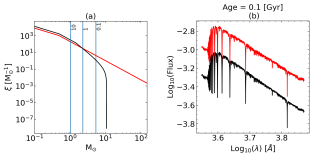We obtained GALEX FUV, NUV, and Spitzer/IRAC 3.6 µm photometry for >2000 galaxies, available for 90% of the S4G sample. We find a very tight "GALEX Blue Sequence (GBS)" in the (FUV − NUV) versus (NUV − [3.6]) color-color diagram which is populated by irregular and spiral galaxies, and is mainly driven by changes in the formation timescale (τ ) and a degeneracy between τ and dust reddening. The tightness of the GBS provides an unprecedented way of identifying starforming galaxies and objects that are just evolving to (or from) what we call the "GALEX Green Valley (GGV)". At the red end of the GBS, at (NUV − [3.6]) > 5, we find a wider "GALEX Red Sequence (GRS)" mostly populated by E/S0 galaxies that has a perpendicular slope to that of the GBS and of the optical red sequence. We find no such dichotomy in terms of stellar mass (measured by M_[3.6]), since both massive (M_* > 10^11 M_solar) blue and red sequence galaxies are identified. The type that is proportionally more often found in the GGV are the S0-Sa's and most of these are located in high-density environments. We discuss evolutionary models of galaxies that show a rapid transition from the blue to the red sequence on timescale of 10^8 years.
This research was performed in the context of the DAGAL project (dagalnetwork.eu), funded by an ITN grant from the EU.
1 Departamento de Astrofísica y CC. de la Atmósfera, Universidad Complutense de Madrid, E-28040 Madrid, Spain
2 Aix Marseille Université, CNGRS, LAM (Laboratoire d'Astrophysique de Marseille) UMR 7326, F-13388 Marseille, France
3 I.N.A.F., Osservatorio Astronomico di Bologna, via Ranzani 1 I-40127 Bologna, Italy
4 European Southern Observatory, Casilla 19001, Santiago 19, Chile
5 National Radio Astronomy Observatory/NAASC, 520 Edgemont Road, Charlottesville, VA 22903, USA
6 Steward Observatory, University of Arizona, 933 North Cherry Avenue, Tucson, AZ 85721, USA
7 Astronomy Division, Department of Physics, University of Oulu, P.O. Box 3000, FIN-90014 Oulu, Finland
8 Kapteyn Astronomical Institute, Postbus 800, NL-9700 AV Groningen, The Netherlands
9 Instituto de Astrofísica de Canarias, Vía Láctea, S/N, E-38205 La Laguna, Spain
10 Departamento de Astrofísica, Universidad de La Laguna, E-38205 La Laguna, Tenerife, Spain
![Figure caption: Left : (FUV − NUV) versus (NUV − [3.6]) color-color diagram. Morphological types are represented by color (see legend). We define the blue and red sequence by dividing the plot into two regions and fitting a least-squares 1-D polynomial (a Figure caption: Left : (FUV − NUV) versus (NUV − [3.6]) color-color diagram. Morphological types are represented by color (see legend). We define the blue and red sequence by dividing the plot into two regions and fitting a least-squares 1-D polynomial (a](/sites/default/files/styles/crop_rectangle_21x9_to_1280/public/images/news/resultados145_157.jpg?itok=gHxt1tK4)


